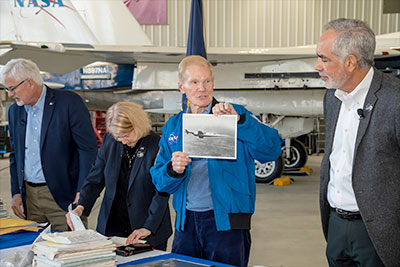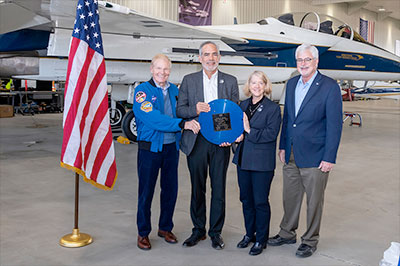NASA Administrator Helps Review Time CapsuleA 25-year-old mystery to most people was solved this week at NASA's Armstrong Flight Research Center in Edwards California.

Above: NASA Administrator Bill Nelson shows a picture of the X-3 to NASA Armstrong Flight Research Center Director David McBride on Oct. 13. NASA Armstrong Deputy Center Director Patrick Stoliker and NASA Deputy Administrator Pam Melroy also are with Nelson and McBride. The X-3 photo was contained in a time capsule that was sealed on the center's 50th anniversary and opened to commemorate its 75th anniversary. NASA Armstrong is in Edwards, California. (NASA/Joshua Fisher)
A time capsule sealed during the center's 50th Anniversary in 1996 was opened to unveil the treasures left there for this generation. NASA Administrator Bill Nelson, NASA Deputy Administrator Pam Melroy, and NASA Armstrong officials reviewed the contents of the capsule on Oct. 13 as part of the center's ongoing 75th anniversary celebration.
NASA Armstrong's origins date back to 1946, when a small group of National Advisory Committee for Aeronautics engineers were sent to Muroc Army Air Field (now Edwards Air Force Base in Edwards California). They began preparations to support the X-1 rocket plane and piercing the sound barrier. The center continues advancing technology and science through flight and makes flight safer, more economical, and environmentally friendly.
NASA Armstrong Center Director David McBride provided background on the capsule, as Walt Kondracki, center aviation maintenance crew chief, opened it up. The time capsule was placed in the cockpit of the X-1E that is displayed outside the center's main building in 1996. Each organization was asked to contribute to the capsule before it was sealed in 1996.
Items in the time capsule included budgets from fiscal year 1997 from the Comptroller's Office, an aerial photo of the center from Research Facilities, an 8-inch floppy disk and punch card from Information Services, a research aircraft fleet image from Flight Operations, a VHS video from Aerospace Projects, and photos of research aircraft from Projects.
Also in the capsule were research papers from Research Engineering, an earthquake response plan from Safety, and Hispanic Heritage Program photos, the Flights of Discovery book, and the center's strategic plan from the Office of the Center Director. Perhaps one of the most valuable items was a collection of about 30 entries that included text and drawings from local school children, called Aeronautics 2020, on what they thought the future would look like.
In addition, the time capsule included a newspaper front page article on the center's 50th anniversary, coins commemorating the 20th anniversary of the F-8 Digital-By-Wire and the F-8 Supercritical Wing projects, and a photo of the center's staff behind the 4802 Hangar.

Above: NASA Administrator Bill Nelson, from left, NASA Armstrong Flight Research Center Director David McBride, NASA Deputy Administrator Pam Melroy, and NASA Armstrong Deputy Center Director Patrick Stoliker, display the lid to a time capsule on Oct. 13. The time capsule was sealed on the center's 50th anniversary and opened to commemorate its 75th anniversary. NASA Armstrong is in Edwards, California. (NASA/Joshua Fisher)
A new effort is underway to select items for a time capsule that will be opened during the center's 100th anniversary.
While it was Nelson's first visit to the center as NASA administrator, he had been at the center before. He was a payload specialist on space shuttle Columbia's STS-61-C mission, which landed at Edwards on Jan. 18, 1986. Also on that shuttle mission was pilot Charlie Bolden, who also was a NASA administrator from 2009-2017.
Nelson noted the time capsule was opened in the same hangar that houses the F-15 that will chase the X-59 Quiet SuperSonic Technology aircraft.
Nelson highlighted upcoming major NASA missions including crewed missions to the International Space Station, the Lucy spacecraft is set to begin a 12-year mission later this month to travel to eight asteroids, the Double Asteroid Redirection Test is set for launch in November, and December features the scheduled launch of the James Webb Space Telescope.
Deputy NASA Administrator Pam Melroy is familiar with Edwards Air Force Base and NASA Armstrong, having graduated from the U.S. Air Force Test Pilot School and becoming a test pilot on the C-17. She was the pilot on space shuttle Discovery when it landed at Edwards Air Force Base on Oct. 24, 2000. She later became the second woman to command a space shuttle in 2007 with the space shuttle Discovery.
Melroy believes the X-59 and the X-57 Maxwell electric aircraft could have enormous impact. The X-59 Quiet SuperSonic Technology aircraft will show that an aircraft can travel supersonically without the loud booms, which could provide information to the Federal Aviation Administration for permitting supersonic flight over land. The X-57 Maxwell electric propulsion aircraft will be validating distributed electric propulsion.
Nelson, Melroy and the NASA Headquarters visitors visited the center's Building 703 in Palmdale, California, to get updates on the DC-8, ER-2, and the Stratospheric Observatory for Infrared Astronomy science aircraft on Oct. 12. While in the area, they also visited Lockheed Martin in Palmdale, where the X-59 is under construction and traveled to NASA's industry partner Masten Space Systems in nearby Mojave, California.
As part of Nelson's West Coast visit, he also visited NASA's Ames Research Center in California's Silicon Valley and the Jet Propulsion Laboratory in Pasadena, California.













